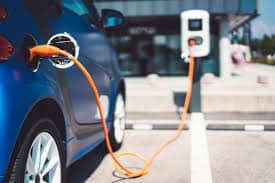With transportation identified as a major environment polluter, the move from fossil fuels to electric vehicles is seeing a major push from central and state governments. Consumers too are warming to the idea of switching to electric vehicles (EVs) for personal transport given that both petrol and diesel prices have crossed the Rs 100 per litre mark.
Are we ready for this?
ADDA, the apartment management software platform and Citizen Matters organised an online panel discussion with different stakeholders on September 29th to look at possible solutions. The discussion focussed on how gated communities, in particular, could facilitate this effort.
The biggest advantage for such communities is that availability of space for charging stations is not much of a problem. The EV charging stations can be at ground level and in common areas. Basement parking spaces can be connected using a bus cable setup. Permission for individual charging points is not required, provided safety is not compromised during cabling work.
According to an ADDA survey on EV adoption in communities across the country, 93.1% do not have an EV charging setup in their communities, while 92.7% are looking to set up a charging station. Respondents shared the following challenges:
- Finding the right vendor
- Judging reliability is a big challenge
- Location of charging stations
- Connectivity hurdles
- Infrastructure requirements
- Safety
The panelists included Tadasmi Koul, Director (Sales India), SemaConnect, Vishnu Gattupalli, Governing Council Member, Bangalore Apartments Federation, Pawan Mulukutla, Director, Electric Mobility, WRI India, Ashika Sripathi, Co-Founder & Chief Evangelist, ADDA, Nilay Chandra, Vice President, Marketing and Charging Infrastructure, Ather Energy, Sandeep Bangia, Business Head, EV Charging Ecosystem, Tata Power, and was moderated by Meera K, co-founder of Citizen Matters.
Read more: Guide to setting up Electric Vehicle Charging Stations in your community
Some key points from the discussion
Technology: Charging infrastructure is the key to the viability of EVs for private transport. What are the needs and challenges here?
Tadasmi Koul, Director (Sales India), SemaConnect: Electric vehicles have an electric motor instead of an internal combustion engine. It uses a large traction battery pack to power the electric motor and must be plugged into a wall outlet or charging station. The charging options are:
- Slow charging Alternate Current (AC) systems like:
- Trickle charge: Entry level slow charging AC systems which work via regular power supply eg. a three-point plug.
- AC Charging Level Two, which is the same system with a slightly higher power output with the ability to work on a software platform, and allows one to schedule timings for charging.
- Direct Current (DC) fast charging. This has:
- Higher power outputs and gives quicker turnarounds.
- But DC costs a lot more because of additional infrastructure needed to get power output to the required level.
- Also, continuous charging can cause battery degradation over time. DC charging on a daily basis is not recommended.

I think the optimal solution would be to AC being the majority and DC being used for emergency purposes. We have seen this in the US where, in the last decade, 80% of charging in homes and offices is done using the AC format.
It’s not a matter of whether EVs are going to take over, it’s only a question of when. And the quicker we adapt to this changing scenario, the better it will be for us.
One key challenge to widespread adoption of EVs is having the right infrastructure and logistics in place. What are the challenges and trade offs here?
Nilay Chandra, Vice President, Marketing and Charging Infrastructure, Ather Energy: There is a general lack of awareness and urgency. One key issue is compatibility. Internationally, there are no standard connectors for two wheelers. The union government has now standardised AC charges for two wheelers which enables companies to create compatible products. Standardizing DC charging for two wheelers will take some more time. The CCS2 method of charging used by most automobile manufacturers is likely to be the standard format for four wheelers.
With standardization, more installations that we see in apartment complexes or in gated communities will get compatible. It will probably take about six months to a year for these products to become commonplace.”
While charging on the go is not possible, is battery swapping an option?
Sandeep Bangia, Business Head, EV Charging Ecosystem, Tata Power: Battery swapping as a concept is favourable for the three-wheeler delivery ecosystem which operates in a limited geography of 8-10 kilometre radius. Batteries are very heavy. A two wheeler 3-4 watt battery can weigh 10-12 kgs, which makes it unwieldy. For swapping, the form factor of the battery needs to be standard and unified.
The good news is that the government is offering subsidies and incentives for everything, including battery swapping, charging, vehicles, scooters, cars, etc. and all these incentives are available to every partner in the ecosystem.
Whenever there is a tectonic shift in the technology or in the way of doing things, normally, funds come in the way and block things. This is the time when progressive residential associations or communities will go out there and take up what is the right thing for them and benefit from it.
What are the chances of fuel cells being a viable option:
Sandeep Bangia, Business Head, EV Charging Ecosystem, Tata Power: With Fuel cells there are challenges in storage, etc., so I don’t see that becoming mainstream. However, fuel cells can become mainstream for trucks because that’s where the long distances are involved. But really for personal vehicles or for residential installations, no way fuel cell is going to become mainstream electric vehicles is the way to go.
The economics of charging stations
Current power tariff for EV charging
| Commercial charging stations | 18/- per unit (kWh) |
| Individual meter | 9/- per unit (kWh) |
| Community meter | 8.5/- per unit (kWh) |
| Rate of investment* | at 30% capacity utilization is 3-4 years |
| With LT6 connection | unit charges -5.45/- + fixed charges |
*subject to configuration, set up, etc
** RWAs can fix flexible rates for community charging

Cost of chargers can also be high. Current rates are:
| Individual | Depending on the type of charger being used – basic charger of 3.3 kWh costs Rs 3,000-5,000 (cabling, labour, etc. are extra) |
| Community Charging | Mixed use charging – 2 wheelers and 4 wheelers |
| Slow AC charger | Costs approximately around Rs 70,000 (5 chargers) |
| Fast DC charger | Costs around Rs 6 to 7 lakhs |
| Expenditure | Both CAPEX and OPEX options are available |
| Miscellaneous | Additional Transformer may be required for large community charging stations. |
Read more: Why e-vehicles aren’t popular in Bengaluru, and how this can change
What about sustainability and scale of adoption? Especially in apartment complexes?
Pawan Mulukutla, Director, Electric Mobility, WRI India: I would suggest creating guidelines to be incorporated in building bylaws to earmark 20% for parking and mandating it for new constructions. Whilst there is no minimum requirement, the rule of thumb for the number of EVs in an apartment for establishing EV charging stations can be 2%. In some Scandinavian countries, it is 50%.
RWAs are responsible for festivals in the community, they are responsible for cleanliness in their community, they are also responsible for climate change (caused by) the community. So transitioning in mobility by adopting cleaner technologies like EV is a good starting point.
Vishnu Gattupalli, Governing Council Member, Bangalore Apartments Federation: The number of EVs, both two and four wheelers, are increasing, so apartments are forced to come up with a solution. From a commercial point of view, unlike rooftop solar installations, EV stations are not capital intensive. From the process point of view, RWAs need to identify the demand via a survey, engage vendors to identify optimal configuration and pricing options and then get a buy-in from a general body meeting. So it’s not really complex and it’s not a financial burden either. I would say it’s a matter of awareness.
See: Bangalore Apartment Federation guide on Community Charging Stations for Electric Vehicles

The pros and cons of EVs
- Pollution
- Electric vehicles are 37% less polluting than fossil fuel.
- No noise pollution.
- Tailpipe emission is completely eradicated.
- Efficiency
- Well to wheel concept – EV is far more efficient than fossil fuel.
- Batteries Recycling
- Automobiles have a second life.
- There is economic viability as the battery can be reused multiple times.
- The government has mandated that the OEMs have the capability or have partnerships for battery recycling.
Policy
Karnataka Electric Vehicle and Energy Storage Policy targets 100% electric mobility by 2030 for certain vehicle segments — auto rickshaws, cabs, corporate fleets, school buses, public transport buses, and three- and four-wheeler goods vehicles. A snapshot of the current EV adoption in Bengaluru in terms of the number of kilometres driven:
- 6000 intra-city buses x 150-200 km per day = 12 lakh km
- One lakh taxis x 200 km = 350 lakh km
- 14.85 lakh private cars x 10 km = 150 lakh km
- Of the 1500 electric buses, Bangalore Metropolitan Transport Corporation (BMTC) on September 30th unveiled the first of 90 electric buses which will be operated as feeder services to Namma Metro.
The entire webinar can be viewed here.